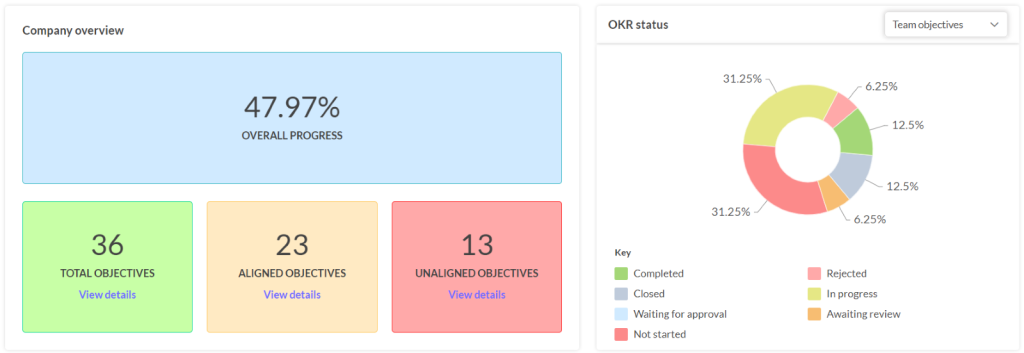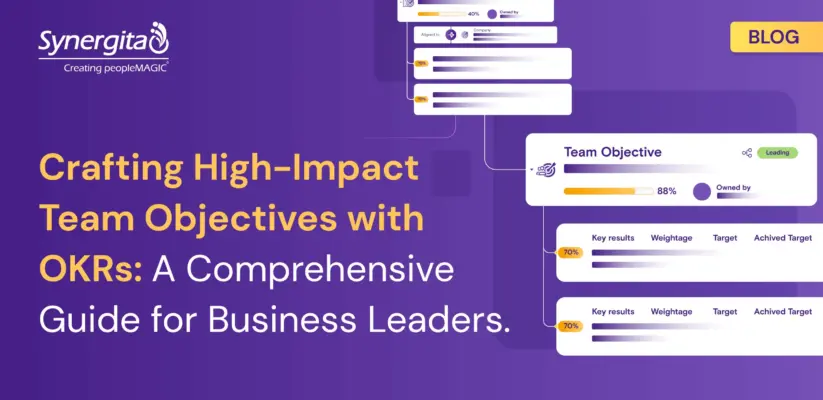Crafting High-Impact Team Objectives with OKRs: A Comprehensive Guide for Business Leaders
Achieving ambitious goals and driving growth demands aligned teams working towards a shared vision. Objectives and Key Results (OKRs) provide a powerful framework for setting clear, measurable, and aspirational objectives at the team level. This guide offers business leaders and department heads a comprehensive roadmap for crafting effective team OKRs, leveraging best practices, avoiding common pitfalls, and ensuring successful implementation.
Key Considerations for Business Heads and Department Heads:
Alignment :
Ensure team OKRs directly contribute to overarching company goals, creating a sense of shared purpose and direction.Participation:
Involve team members in goal setting to foster ownership and engagement.Ambition:
Set challenging but realistic objectives to motivate and empower teams without setting them up for failure.Measurability:
Choose quantifiable key results to enable data-driven decision-making and progress tracking.Collaboration:
Align team OKRs across departments to eliminate silos and optimize resource allocation, a strategy often seen in successful business to business software.Transparency :
Foster open communication and shared accountability through transparent progress tracking and regular feedback loops.Reviews:
Establish a consistent review cadence (e.g., weekly or bi-weekly) to track progress, adapt to changes, and celebrate milestones.
Crafting Effective Team Objectives:
Best Practices
To ensure business growth through impactful team performance, these are the best practices to be followed:
Impact Driven:
Prioritize objectives that not only directly contribute to company goals, but also create meaningful value, which are the benchmarks of effective business OKRs.Clarity and Conciseness:
Use clear, concise language that everyone can understand.Leveraging Strengths:
Align objectives with team members’ expertise and passions to drive engagement.Achievability:
Set objectives that are challenging but attainable within the designated timeframe to maintain momentum and ensure continuous leadership development.
Some examples of good OKRs, which reflect a balance of ambition and achievability, are outlined below. Business leaders can also streamline the OKR development process by utilizing pre-existing templates for business, like those found in Synergita OKR, to ensure consistency and clarity across team objectives.
Marketing :
Objective: Increase brand awareness by 20% among target audience.
- Key Result 1: Increase website traffic by 15%.
- Key Result 2: Generate 5,000 new social media followers.
Objective: Improve customer satisfaction with marketing campaigns.
- Key Result 1: Increase positive customer reviews by 10%.
- Key Result 2: Reduce marketing-related customer complaints by 5%.

Sales:
Objective: Increase sales revenue by 15%.
- Key Result 1: Close 100 new deals.
- Key Result 2: Increase average deal size by 5%.
Objective: Shorten sales cycle by 10%.
- Key Result 1: Reduce time to first contact with leads by 2 days.
- Key Result 2: Increase conversion rate from lead to opportunity by 5%.

Product:
Objective: Launch new product feature X on time and within budget.
- Key Result 1: Complete development by the end of Q2.
- Key Result 2: Achieve 95% user satisfaction in beta testing.
Objective: Reduce product defects by 20%.
- Key Result 1: Identify and fix 50 critical bugs.
- Key Result 2: Decrease customer support tickets related to product issues by 10%.

Engineering:
Objective: Improve website uptime to 99.9%.
- Key Result 1: Reduce downtime incidents by 50%.
- Key Result 2: Implement a new monitoring system to detect and address issues proactively.
Objective: Reduce development cycle time by 15%.
- Key Result 1: Automate 20% of manual testing tasks.
- Key Result 2: Implement continuous integration and delivery (CI/CD) pipeline.
Human Resources:
Objective: Improve employee engagement and retention
- Key Result 1: Reduce voluntary employee turnover by 8% within the next 6 months.
- Key Result 2: Achieve 90% participation in performance review and development planning processes.
- Key Result 3: Implement a peer-to-peer recognition program with at least 70% employee participation within 3 months.
Objective: Enhance diversity, equity, and inclusion (DE&I) in the workplace
- Key Result 1: Increase representation of underrepresented groups in the workforce by 7% within the next year.
- Key Result 2: Implement unconscious bias training for all managers and employees with a 95% completion rate.
- Key Result 3: Conduct a comprehensive review of hiring and promotion practices to identify and address potential biases, implementing necessary changes within 4 months.
- Key Result 4: Establish employee resource groups (ERGs) for at least three underrepresented groups with 20% participation within 6 months.

Avoiding Common Pitfalls:
- Cascading Misalignment: Ensure team OKRs directly contribute to and seamlessly cascade from company priorities, avoiding confusion and misdirection. Remember, the company’s objectives form the foundation, and team OKRs should act as building blocks that support and drive these overarching business goals.
- Vanity metrics: Focus on key results that measure impactful outcomes, not just superficial statistics. Avoid metrics like website traffic or follower count unless they directly connect to specific objectives, like increasing brand awareness or boosting user engagement. Choose key results that track progress towards meaningful results like sales conversions or customer satisfaction.
- Lack of transparency and communication: Foster a culture of open communication and regularly share progress updates, feedback, and adjustments to maintain team alignment. This transparency facilitates ongoing leadership development by ensuring that everyone is aligned and informed. Utilize platforms like dashboards and communication tools to keep everyone informed and engaged.
- Infrequent progress reviews: Establish a consistent review cadence (e.g., weekly or bi-weekly) to address roadblocks, celebrate successes, and ensure course correction if needed. Regular check-ins keep the team focused on objectives and allow for timely adjustments if circumstances change.
- Fear of failure and unrealistic expectations: Create a safe environment where experimentation and learning are encouraged. Set ambitious yet chievable objectives, acknowledging that unforeseen challenges may arise. Be open to adjusting OKRs based on progress and new insights, without penalizing teams for facing temporary setbacks.
Team OKR dashboards:
- Choose the Right Metrics: Select quantifiable metrics that directly align with key results and accurately reflect progress towards objective achievement. Use specific, measurable, achievable, relevant, and time-bound (SMART) criteria to ensure your metrics are effective.

2. Track progress consistently: Utilize dashboards, reports, and other tools to monitor progress in real-time and identify areas for improvement. Make data readily available to everyone involved, fostering transparency and accountability.
3. Celebrate Milestones and Achievements: Recognize and celebrate even small wins to maintain team morale and motivation. Highlighting progress keeps everyone engaged and reinforces the importance of their contributions.
4. Conduct Regular Reviews and Assessments: Use progress data to inform objective adjustments, resource allocation, and future goal setting. Regular evaluations ensure your OKR framework remains relevant and impactful.
Addressing Business and Department Heads:
- Provide resources and support: Equip teams with the necessary tools, training, and expertise to achieve their OKRs successfully. Allocate resources like budget, software licenses from top business to business software providers, and training courses to empower teams to reach their goals.
- Promote a culture of ownership: Encourage team members to actively participate in goal setting, progress tracking, and decision-making. Empower them to take ownership of their work and contribute to the team’s success.
- Promote cross-functional Collaboration: Facilitate open communication and collaboration between teams to overcome challenges and optimize workflows. Encourage teams to share knowledge, resources, and expertise to achieve mutual goals, embodying the principles of leadership and development.
- Offer constructive feedback and guidance: Provide regular feedback and support to help teams stay on track and achieve their objectives. Offer guidance and mentorship, while allowing teams the autonomy to solve problems and make decisions independently.
In conclusion, crafting high-impact team OKRs is not simply about setting goals, but about igniting a shared fire within your organization. By aligning team objectives with company priorities, emphasizing measurable outcomes, and fostering a culture of transparency and collaboration, you unlock the collective potential of your workforce. Remember, successful OKRs are a journey, not a destination. Embrace regular reviews, celebrate milestones, and learn from setbacks. Be the guide, not the dictator, empowering your teams to take ownership and creatively solve problems. With the right approach, OKRs can become the compass that navigates your organization towards a future of shared success, leaving behind a trail of impactful achievements.
